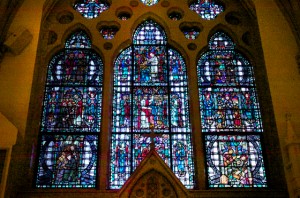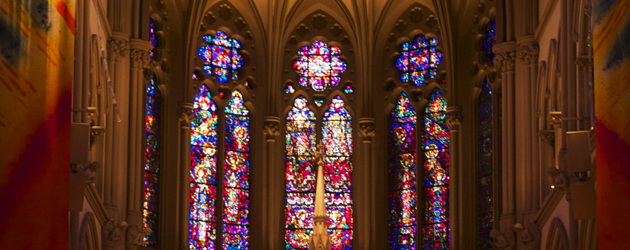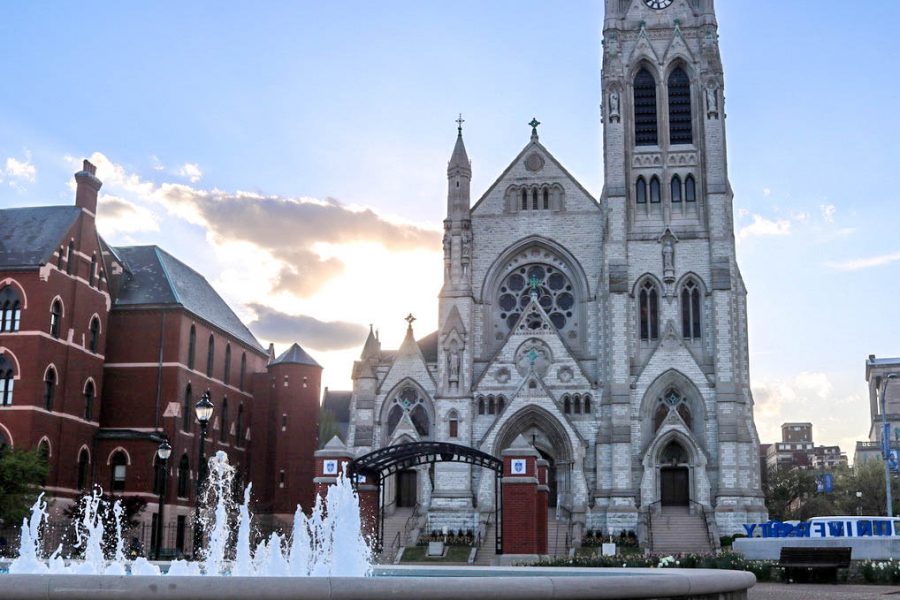Father J.J. Mueller describes his fascination with the windows of St. Xavier Church
At a 9 p.m. Mass, where lighting is minimal, it’s easy for students to overlook the stained glass windows that line the walls of Saint Francis Xavier College Church. However, Father J.J. Mueller has spent the past three years studying the hidden and rich history of these windows and the stories they tell.

Mueller makes it clear that these windows are something special, not to be ignored. “They’re stupendous,” he said. After a moment, he added, “and their detail makes them double stupendous. The fact that they’re storytellers makes it triple fantastic. …. As far as Jesuitica does, this is the finest. I don’t know of anything better, even in Europe.”
His passion for these windows stems largely from their many intricacies. It takes time to figure them out. Mueller can point out many minute details in each window that, as he said, “if someone else walked through here, they’d never [notice].” One thing he pointed out is a small church in the corner of Saint Francis Xavier’s death scene. That church is an exact copy of the church on Shangchuan Island, where Xavier died.
Another small detail is in a scene of King Solomon. Small images of two women, one holding an infant and another waving her arms in distress, signify the famous story of Solomon’s wisdom. There are six windows on each main side of the building, each portraying a different saint. (The exception is one window along the south wall that includes multiple North American martyrs.) The windows are topped with decorative octagons, angels, quatrefoils, and trefoils, but the three panels below make up the bulk of the story of the saint.
Mueller explained that the windows must be read in a specific way. They read from top to bottom, starting with the left panel, then the right one, and finishing with the middle. The side panels tell the story of the life of the saint through six important events. The middle panel connects the saint to both Jesus and a story from the Old Testament: the top shows the most important event in the saint’s work, the middle a scene of Jesus, and the bottom a story from the Old Testament, all connected through a theme.
These patterns and rules, however, are often bent.
“It’s fun,” said Mueller about the patterns. “All of a sudden things will change.”
For example, most of the panels start with a scene of the saint as a child with his family — but neither Saint Ignatius’s or Saint Francis Xavier’s do. The window with the martyrs of North America breaks the pattern of having one saint per window. Through these patterns, intricate work, and excellent craftsmanship, one window is able to tell the long, complex story of a saint. For example, the window closest to the altar on the south wall displays Saint Ignatius of Loyola, the founder of the Society of Jesus.
Six scenes tell the story of Ignatius’ life on the side panels:
1. Ignatius wounded in battle.
2. Ignatius while healing, switching his sword out for Mary and Jesus.
3. Ignatius on his pilgrimage in the Holy Land.
4. Ignatius meeting Paul III, the Pope who approved the Society of Jesus as an order.
5. Ignatius sending Saint Francis Xavier out to do missionary work.
6. Ignatius saying Mass.
In the middle panel, the top portrays Ignatius at Manresa, writing the Spiritual Exercises. In the center is Jesus during his fast, and at the bottom, Elijah during his fast. This these of fasting shows all three men waiting for God to enter.
Father Mueller told this story as he pointed out specifics in the window, and he could do the same, in even more detail, for each of the other eleven windows. His interest in these windows began years ago.
“I became enamored with them when, after seeing them so often, I wanted began to look more closely at the windows,” he said. “They were beautiful but I could not understand how the windows were arranged, the writing in it, and, basically, how to see a window and its story.”
He spent more and more time researching the windows and their history, taking photos and learning as much as he could.
“I think I fell in love with it,” Mueller said.
Through his research, he learned that these windows were made by the Emil Frei company in the early 30s, during the Great Depression. The company was going through a hard time, but this job kept all their workers on the payroll and sustained them through the Depression.
About three years ago, Mueller estimated, his passion drove him to decide to write a book on the windows. His book will explain how to read the windows, see the patterns and themes the contain, and it will describe and tell the story of each window and the saint it depicts. Alongside his photos, he will highlight details that most people probably miss when viewing the windows.
Mueller and those working with him plan for the book to be finished by September first and then sent to printing, so it should be available sometime in the fall.














